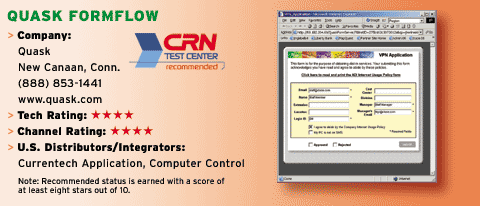Quask Offers Alternative To High-priced Workflow Tools
Because workflows in FormFlow function around forms, users first have to use a scaled-down version of Quask FormArtist to develop forms. From a library of stylesheets, users can quickly customize every aspect of a form page. For example, by selecting any element in a form, users can quickly resize it. Every step is completely WYSIWYG, so the tool is easy to use. For every field or form component that is placed on a page, the tool displays steps that help users determine what values to put in each component using pop-up windows.
Users also can change properties on the fly by right-clicking on a field. Radio buttons, for instance, can be set to activate one or multiple buttons in a group. Randomizing choices also are permitted in some fields. Users also can draw basic shapes and add color to graphical elements in forms.
Accessing data from external sources is also simple with FormFlow. Users can either hard-code choices or connect to a file or database.
If there are a large number of choices, an input text box and a list box can be combined to display only a portion of the available choices based on a search pattern.
FormFlow can combine search buttons with text boxes to display results in a list box. This combination of fields can be put together without coding the logic that ties in the data with the fields in a form.
In addition to HTML form fields, FormFlow arrives with a list of animated emoticons, custom buttons, sound effects and a file-attachment component. The software's form editor allows users to create highly customizable forms without coding.
After a form has been designed, users need to add validations, calculations and conditional branching scripts to create an actual workflow. FormFlow's scripting capabilities provide a unique approach to workflow processing. While most vendors in the workflow space follow BPEL and provide process functionality using statements in graphical forms, Quask decided to stick to the basics. In FormFlow, users have to learn a series of high-level statements before they can manipulate form logic.
According to Quask engineers, any user can learn FormFlow's scripting language, but CRN Test Center engineers found that advanced users or developers are better suited to work with FormFlow workflows. What's more, FormFlow uses a low-level .Net configuration file to initiate triggers with external components. This process requires an understanding of .Net's architecture and programming model.
FormFlow code is e-mail-driven, meaning that every interaction that takes place between users is led by e-mail links to forms. E-mails provide sequencing between each page on a form, so the scripting is broken up between each user's e-mail activities. Developers also can change a form's behavior for different users by setting read-only attributes on fields or by hiding fields based on user rights.
Since FormFlow uses a scripting language, coding is interactive. Developers must constantly jump between completed form previews and the actual script editor, which is not ideal. CRN Test Center engineers would have preferred to see a graphical workflow diagram feature that displays scripts using icon-based logic. Right now, script access is limited to programmers and cannot be understood by non-technical users.
Test Center engineers did like the way that logical statements can be used to easily control fields on a form. Using a simple two-line statement, any field can be made visible or invisible based on user input.
FormFlow mostly generates client-side code to remove most interaction with the server. The server creates dynamic behavior in forms that change as users fill out forms.
FormFlow is priced at just less than $15,000. The software's relatively low price and extensive feature set provides a good opportunity for solution providers looking to develop Web form-driven workflows.
FormFlow's scripting language has major advantages because it provides developers with more control over forms. Alternatively, many competing workflow software packages only allow developers to rely on graphical logic constructs while hiding most of the code in XML files.
Quask has a four-tier channel program that bases partner level on commission rates. Solution providers receive discounts of 30 percent to 50 percent based on annual purchases of up to $150,000. Since FormFlow is a new product, the company said it has not yet decided how to differentiate support levels for each partner level.
